NEONATOLOGY ON THE WEB
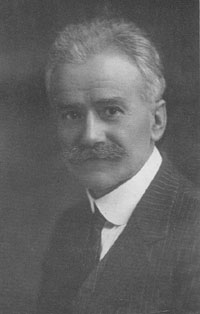
|
The Baby Incubators on the "Pike."
A Study of the Care of Premature Infants in Incubator
Hospitals Erected for Show Purposes.
Part 4.
By John Zahorsky, M.D.,
St. Louis, Mo.
St. Louis Courier of Medicine 32(3):152-166,
March, 1905.
(Continued from page 80, February, 1905, Number).
|
Other Indications.
While the rectal temperature must remain the most reliable
criterion of the proper incubator temperature, it is by no means
always accurate. The infant has a thermo-regulating mechanism,
however feeble it may be in some, which controls to a certain extent
the internal temperature. Thus, the lessened flow of blood to the
extremities results in cold hands, which can be touched by the nurse
at every feeding. Cold hands and feet may mean insufficient
oxygenation, feeble circulation or an insufficiently heated
incubator.
On the other hand, thermotaxis is strained by an incubator that is
too warm, and perspiration may be found on the forehead of the
feeblest infant. It is a sharp reproof that too much heat has been
used. Often the perspiration in a warm incubator is not sensible,
since the warm air favors rapid evaporation, and the activity of the
sudoriferous glands is manifest by the appearance of sudamina and
miliaria. Thus, in the case of St. Louis, who on account of a severe
indigestion, had a subnormal temperature, the incubator heat was
elevated to 92°, and on two or three occasions a very intense
erythematous blush appeared, on the edges of which were typical
sudamina and miliaria maculopapules. Yet this infant had suffered
from hypothermia, with the incubator at 90°, for several days,
caused by indigestion. When the incubator was elevated to 92 to
93°, the skin lesions appeared, without an abnormal rise in
temperature, showing the adjustment of the organism to the increased
heat supply.
It is obvious that the adjustment of the incubator temperature to
the needs of the infant presents many difficulties. Different
observers will regard the several indications with a varying
importance, and hence, the great differences in opinion. There can be
no question that the baby should be warm and comfortable. Some will
feel most comfortable with a rectal temperature of 97°, others
will need 99°, or even a fraction more. I shall refer to other
phases of this in treating of special diseases.
While it was the rule to take the rectal temperature from two to
four times daily, in every case of cyanosis the temperature was taken
as an additional precaution (see Cyanosis). Repeated vomiting also
should suggest a more careful watch. A very rapid loss in weight,
when no other cause can be assigned, demands inquiry into the heat
supply. Somnolence or cutaneous hyperesthesia are indications for
inquiry into the bodily temperature. A convulsion may be the first
sign of overheating.
IV.
The Food.
While Rotch and Morse have had very good results in feeding
premature infants on modified cows' milk, and in private practice it
may at times be impossible to obtain a wet nurse, in an institution
human milk is alone permissible. The advantages are so many that it
does not seem worth the while to make comparisons. Rotch's argument
that cows' milk can be accurately modified to the needs of the infant
does not hold, since the human milk may also be modified. But the
comparative sterile nature, the easier digestibility and the
immunity-conferring properties of human milk are sufficient to
counterbalance any possible advantage derived from an accurate
control of any composition. Hence, wet-nurses must be obtained. We
had five wet-nurses who, with their infants, slept in another part of
the building. They furnished the milk but had nothing to do with the
care of the incubator babies.
The Wet-Nurses.
In the selection of wet-nurses I was guided by different
principles than are usually expressed, since the assumption that a
proper wet-nurse for such an infant is its mother or a wet-nurse
whose infant is very young does not stand a critical analysis. It is
a well-known clinical observation that young infants during the first
few weeks of lactation are subject to a variety of dyspeptic
disturbances, attributable to deleterious changes in the composition
of mothers' milk. Reference to diarrhea, colitis, vomiting and
flatulent colic is all that is necessary. Then, again, we know from
the researches of Soldner and Camerer, Pfeiffer and others that human
milk is strongest in the early days of lactation and gradually
becomes weaker in proteids as the period advances. In a series of
analyses they found the following averages (Zeitschr. f.
Biologie, Band xxxiii):
|
Time of lactation, day.
|
Nitrogenous substances.
|
Solids.
|
|
5
|
2.95
|
11.7
|
|
8 to 11
|
2.53
|
12.25
|
|
20 to 40
|
1.78
|
12.35
|
|
70 to 120
|
1.43
|
11.44
|
|
170
|
1.08
|
10.85
|
Obviously, a wet-nurse whose infant is at least three months old,
is most suitable for the premature baby.
Naturally, the general health of the wet-nurse must be carefully
investigated, but local disease of any kind (nose, throat, skin,
etc.)must also receive consideration. A small, well protuberant
mammilla is desirable.
Our nurses had all passed the third month of lactation, and as far
as could be ascertained, except in one instance, the milk was in
every way suitable.
Another question is concerning the number of wet-nurses required.
A wet-nurse should be able to supply the needs of two or three
premature infants. Budin found that under proper feeding and
increased demands of repeated nursing the milk gradually increased in
quantity up to a certain limit.
Milk -- How Obtained?
Infants weighing less than 1800 grams are generally too feeble to
nurse the breast and must be fed some other way, hence it was our
custom to have the milk drawn and the prescribed quantity fed in
other ways. The milk was occasionally drawn from the breast by means
of the breast pump; generally the milk was drawn by manipulation,
that is, a process of milking. It is really surprising, after a few
days of practice, how readily the wet-nurse can "draw" her milk from
her breast by "milking." The milk was drawn into sterilized glasses,
poured into other sterilized glasses and kept in the ice box. This
"milking" took place four or five times a day. In addition, the older
infants were placed directly to the breast.
Composition of the Milk.
No chemical analysis was made of the milk; in our work, I assumed
that the milk of five nurses at different periods would average a
composition as follows: Proteids 1.50, sugar 6.50, and fat 3.75. This
gives a caloric value of 670 large calories to the liter, or about 21
calories to the fluidounce. The calories were obtained in the usual
way -- by regarding the heat value of fat as 9.3 to each gram;
proteids and sugar each were calculated as 4.1 calories to the gram.
For practical purposes the assumptions of an average composition
must be regarded as sufficient, as the daily variations are such that
chemical analysis is almost impossible except in isolated cases where
much milk is to spare.
Heubner considers the caloric value of mothers' milk as varying
between 614 and 724 large calories (Kinderheilkunde, Vol. I)
to the liter, and regards 650 calories as a fair average. I took a
slightly higher average based on the analyses of American women
(Rotch, Holt, etc.).
Methods of Feeding.
The methods of feeding varied with the needs of the patient. Very
small infants -- under 1200 grams, were usually fed with the ordinary
medicine dropper. The nurse fed the milk by dropping one drop after
another on the tongue. In many cases the Breck feeder (see "Rotch's
Text-Book") was used with good results. If the infant was very
feeble, would swallow with difficulty or would be readily become
cyanotic, gavage was employed. When the baby became more vigorous a
small rubber nipple on a small bottle gave excellent satisfaction. A
small nipple may easily be made by perforating the rubber cot on an
ordinary medicine dropper. Later the infant was placed to the breast.
Nasal Feeding.
Monti recommends nasal feeding in premature infants. The milk is
poured gradually into the nose by means of a small funnel.
Finkelstein has also given his sanction to this method. Some writers,
e.g. Batten, Lancet, 1899, have found nasal feeding very
advantageous in persistent vomiting of the newly-born.
In older children -- after 2 years, this method is a
well-recognized procedure, but in the premature the meatus is so
narrow that it is exceedingly difficult to pass a catheter, while to
permit its passage through the nose by gravity, subjects the infant
to the dangers of an acute rhinitis from decomposed milk. It is
impossible to cleanse the nose properly after feeding. In the
nasopharynx, especially, particles of milk are likely to cling and by
decomposition cause irritation, and a toxemia, more or less severe,
may be a consequence.
The principle objection to nasal feeding is that it interferes
with the respiratory tube. I have again and again observed cyanosis,
even fatal, in very small infants result from milk running into the
nasopharynx and nose when the head was kept down in oral feeding.
These babies cannot breathe through their mouth and anything that
tends to obstruct the nose jeopardizes its life.
Gavage.
For the reasons mentioned nasal feeding was not employed, but in
all cases where swallowing could be done only with difficulty,
feeding was accomplished by pouring the required amount of milk into
the stomach through a catheter.
While this does not seem to disturb these infants, in spite of
care, regurgitation with its attendant evils frequently follows the
withdrawal of the tube. The milk should not be forced, but should be
permitted to flow into the stomach slowly by the force of gravity. A
too rapid flow is resented by the stomach. The infant should be held
upright when the tube is introduced, since the recumbent position
favors the flow of the regurgitated milk into the nasopharynx. Still,
in very feeble, cyanotic infants the recumbent position only may be
feasible. In withdrawing the tube great care should be taken that a
drop does not fall into the larynx, which may cause fatal cyanosis.
From our experience I can not help but feel that gavage should be
the preferable method of feeding in infants weighing less than 1200
grams (22 to 26 weeks gestation). In fact, in these cases it should
be used at once without trying the drop method. As will be seen these
feeble infants will become cyanotic on the slightest provocation,
even the act of swallowing inhibiting the respiratory center.
Deglutition is a dangerous act in these infants.
When to Commence Feeding.
While it is the custom with infants born at term to give them very
little food until the milk secretion is established, it is a safer
rule in premature infants to begin administering water and milk a few
hours after birth. Then life depends entirely on the reception of
food, since there is little stored in the tissues.
The Daily Amount.
Before estimating the quantity to be given at each feeding and the
interval between the feedings, it is best to decide how much milk is
to be given in the twenty-four hours. This is a most important
matter, since insufficient nourishment is followed by rapid loss in
weight, hypothermia, cyanosis and death. On the other hand,
overfeeding brings on disastrous results from indigestion, intestinal
putrefaction, somnolence, loss in weight, and fatal atrophy. It is
the duty of the physician, therefore, to adjust the amount of milk to
the digestive power and the needs of the individual infant. The
digestive ability is judged from the condition of the digestive
tract, the character of the stools, the presence or absence of
vomiting, and the approximate amount of urine passed. The needs of
the infant is estimated from its weight, its appetite, and the rectal
temperature.
Most authors find it sufficient to give the quantity at a feeding
and the intervals. Budin, however, lays down definite rules, and from
his large experience these rules must be considered most precise and
extremely practicable. It should be remembered, however, that this
physician only considers infants weighing more than 1200 grams at
birth.
Because time must be allowed for a certain degree of adaptation of
the digestive apparatus to the milk, it is evident that during the
first few days proportionately less nourishment must be administered;
hence, Budin distinguishes two periods in the food adjustment:
1. During the first ten days of life.
2. After ten days.
The first division he again divides into three classes:
a. Infants weighing less than 1800 (1350 to 1800) grams.
b. Infants weighing from 1800 to 2200 grams.
c. Infants weighing more than 2200 grams.
In the accompanying Table 8, I reproduce the average amount of
milk which he gives during the first ten days of life, but have taken
the liberty to annex the caloric value, based on an average
composition (650 calories to the kilogram).
While the amount in these tables seems somewhat arbitrary, it
should be remembered that these figures are averages in quite a
number of cases. It is obvious that the quantity of milk is
progressively increased, so that the infant takes about three times
as much on the tenth day as on the second day. If we calculate the
energy quotient in these quantities with reference to the average
weight (assuming 650 calories to 1000 grams of milk) the figures
indicated in Table 9 are obtained.
I shall have occasion to refer to this table again.
The Amount After Ten Days -- Budin's Rule.
Budin gives a very clear rule by which the proper amount of milk
to be given after ten days' of life may be determined. It may be
stated as follows: Take one-fifth of the weight of the infant, this
gives the quantity of milk to be given to the premature infant in
twenty-four hours. Or, multiply the infant's weight by two and take
one-tenth.
If we assume any weight of an infant as N, one-fifth of
this would be N/5, which is the quantity of milk to be given
to any premature infant. Then 1000/N/5*650 = the number of daily
calories ingested, and N/1000 = the number of kilograms in the
infant's weight.
Hence the energy quotient is 130, that is, 130 calories are given
for each kilogram of weight in twenty-four hours. As I shall discuss
the caloric needs at length later on, it is only necessary to state
that this is approximately the proper amount, as has been
demonstrated clinically in many ways. If there is an error at all, it
is on the side of liberality. As we shall see, my own experience
teaches that this energy quotient at ten days is too high, since
indigestion is the rule if food is given in such large quantities.
We shall next examine some records of the amounts given during my
service (Table 10).
If these figures are compared with those of Budin (Table 8), it
will be seen that the quantities we gave were considerably less for
the corresponding period. And yet, vomiting and indigestion occurred
in several cases. Thus, about the eighth day, St. Louis showed
indigestion as shown by the character of the stools. On the twelfth
day John H. had to have his food reduced for a similar cause. In the
case of John M. there was in the beginning a too rapid increase, so
that a subsequent increase could not be made for many days. In the
case of Bernice, who commenced to vomit on the ninth day, the
reduction in quantity was probably too great, since she cried with
hunger after every feeding.
Perhaps, I was too cautious, but the previous poor results with
overfeeding forced me to go to the other extreme. I shall give only
three examples, and this is not with a view of criticising but rather
to assist in arriving at a satisfactory conclusion as to the proper
quantity to give (Table 11).
From this Table it is seen that the quantity given, with the
exception of the first baby, was less than the averages laid down by
Budin. Still most of these were near 1350 grams in weight. Mildred
was overfed the first day and, consequently showed marked dyspeptic
symptoms lasting for many days, in spite of the reduction of the
daily quantity.
I refrain from giving any more figures from the first series for
the simple reason that the larger infants had to be put on mixed
feeding. Altogether, from this study the conclusion is justifiable
that Budin's figures in regard to the daily quantity of milk are
somewhat high for feeble infants, while for those weighing more than
1800 grams his averages, no doubt, are correct. Still I would prefer
to make the daily increment less large so that at least two weeks
would elapse before the infant gets one fifth of its body weight in
milk for twenty-four hours.
During the latter part of the season I was enabled to draw a
definite formula based on the caloric needs. This gives us a general
rule for the feeding of those babies, which is eminently practical
and, when properly controlled by noting the digestive functions of
the infant, will lead to excellent results. Hence, I offer the
following rules for the feeding of premature infants, and reserve the
following Section (V) for discussing its value and practicability.
Rules for Feeding Premature Infants.
1. During the first day of life the premature infant should
receive sufficient human milk diluted with an equal quantity of
water, or 3 per cent sugar solution, so that the energy quotient
shall be thirty calories. Any fractional part of the first day should
receive a proportionate part of the energy quotient.
2. On the following days the energy quotient should receive an
increment of ten every day, so that an energy quotient of 120
calories is reached by the tenth day. The quantities are represented
in Table 12.
3. In many cases it is best to increase more gradually, especially
if slight dyspeptic symptoms occur. It will be found more safe to
keep the energy quotient the same for two or three days after
reaching eighty, as indicated in Table 13.
4. After two weeks the energy quotient should be maintained near
one hundred and twenty calories.
5. In all cases the stools must be watched for signs of
indigestion. When the stools become greenish, or contain undigested
curds it is best not to increase the energy quotient over eighty
until these symptoms disappear.
The practice of making the energy quotient the basis of infant
feeding is entirely rational, and its value has, as yet, been
scarcely appreciated. While it is true that the length of gestation
must also be considered, the weight must be the most practical guide.
I will give two examples of this method of feeding:
Baby A, arrived at 4 p.m.; weight, 1250 grams. Since its weight
was one and one-fourth kilos, its daily amount of milk must be one
and one-fourth times its energy quotient in calories. And since there
are 670 calories (21 in an ounce) in a liter, the calculation is
easily made, as follows (Table 14).
Of course, all these figures are given in round numbers, I can not
claim that extreme accuracy is necessary. It should also be noticed
that this is a hypothetical case, calculated on the basis of
birthweight; but as the weight decreases during the first week the
figures are somewhat too large. Each time the baby is weighed, and as
we shall see, it should be weighed every day, the quantity of food
for the next twenty-four hours should be calculated. Now, while this
may seem very complex, in a given case a more simple rule can be
followed, but this rule should remain the standard by which other
milk schedules may be judged. Here is an example from actual life at
the Baby Incubators (Table 15) and illustrates the harmful results of
trying to feed too much.
I cite the case of Omega to illustrate how one may begin by
adhering to the rule, but because the vigorous baby seemed so hungry
on the fourth day the food was increased beyond the prescribed limits
and in three days, as marked dyspeptic symptoms appeared, the food
had to be reduced in amount.
From a study of Budin's figures and my own experience, I am
convinced that the schedule given is about correct.
Note -- the first few days the total calories were increased by
giving sugar-water. Where a discrepancy between the milk and calories
appears it is due to the calculated calories in the 5 per cent sugar
water.
Now, since there is a gradual increase of daily allowance of milk,
and the amount the first day is represented by an energy quotient of
30, the daily increment is 10 calories. Moreover, since there are 670
calories in one liter, any quantity of milk is found by taking one
and one half times the calories wanted. Hence, to obtain the quantity
desired for any day (during the first ten days) we have the following
algebraic equation:
x = 3w / 2000 [30 + 10(a-1)]
Whence, x = 3w / 200 (2+a)
Where w stands for the weight of the infant, and a
represents the day of life.
Therefore, I offer the following practical rules to those who do
not wish to calculate the amount of daily feeding on the basis of the
energy quotient:
1. Before the tenth day -- Divide the weight of the
infant by seventy (70) and multiply the quotient by the age plus
two (2).
2. After the tenth day -- Divide the body weight by five (5).
These are simple and practical rules, -- the second rule is that
of Budin.
The Amount at Each Feeding.
It is curious how different physicians take different means of
determining the capacity of the stomach. Rotch has depended mostly on
post-mortem examination of the premature stomach; he reports three
cases. One was a fetus, seven and a half month's gestation, weighing
1930 grams and having a gastric capacity of 18 cc. In another case,
eight month's gestation, while the fetus weighted only 1230 grams,
the stomach could hold 22 cc. In the third case, gestation thirty-two
weeks, weight 1440 grams, the size of the stomach was much smaller,
holding only 8 cc (2 drams).
Voorhees also recommends that the first quantities should be 1 to
2 drams (4 to 8 cc.) and gradually increased.
Perret states that having determined the quantity of milk (method
of Budin) it is easy to decide the quantity of each feeding by
dividing it by the number of feedings daily. He regards ten feedings
as the proper number. Hence, the total quantity divided by ten will
give the amount at each feeding. Budin has a very similar rule.
Monti recommends quantities from 20 to 40 grams.
We followed Voorhees' directions, mainly, beginning with one-half
to two drams (2 to 8 cc.) at a feeding and rapidly increasing.
Efforts at larger quantities frequently resulted in vomiting, which
is dangerous in such infants.
As there is still so much uncertainty concerning the size of the
stomach, considerable latitude must be allowed. I still believe that
having decided the total quantity to be given, we best decide on the
number of feedings daily and divide the quantity of milk by this.
This is a very practical rule.
The Interval.
As to the interval, no definite rule exists. Rotch and Voorhees
feed every hour. Perrett, Budin and Monti insist on two hour
intervals. In fact, Monti finds the hourly feedings of Passini wrong
(theoretically?), an infant should not be fed so often and so much.
In artificially-fed infants he recommends three hour intervals. How
he can get enough food into a premature infant in these intervals is
a mystery. Our rule was about as follows:
Infants weighing less than 1500 grams were fed every hour in day
time, sometimes less often at night (20 to 22 feedings daily).
Infants weighing 1500 to 2500 grams received their food every one
and one-half hours (14 to 16 feedings daily).
Infants weighing more than 2500 grams can receive their food at
two hour intervals.
Of course, the age of the patient must always be considered.
An Example.
The infant weighs 1350 grams (about 3 pounds), 28 week's
gestation. How much food should it receive on the third day of life?
Twenty feedings daily. Energy quotient 50, daily calories 66. This
equals 100 cc. of milk -- each feeding 5 cc.
Figures
|
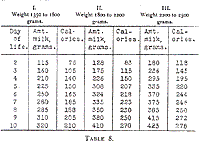
|
Table 8.
|
|
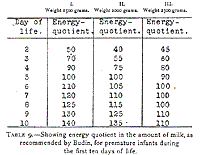
|
Table 9. Showing energy quotient in the amount of milk,
as recommended by Budin, for premature infants during the
first ten days of life.
|
|
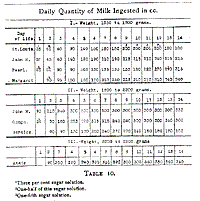
|
Table 10.
|
|

|
Table 11.
|
|

|
Table 12.
|
|
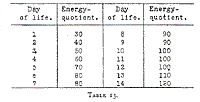
|
Table 13.
|
|
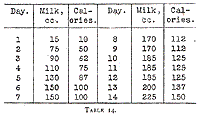
|
Table 14.
|
|
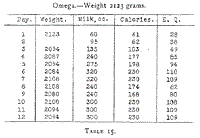
|
Table 15.
|
(To be Continued.)
Return to the Contents Page
Created 6/17/2000 / Last modified 7/16/2020
Copyright © 2000-2020 Neonatology on the Web / webmaster@neonatology.net








